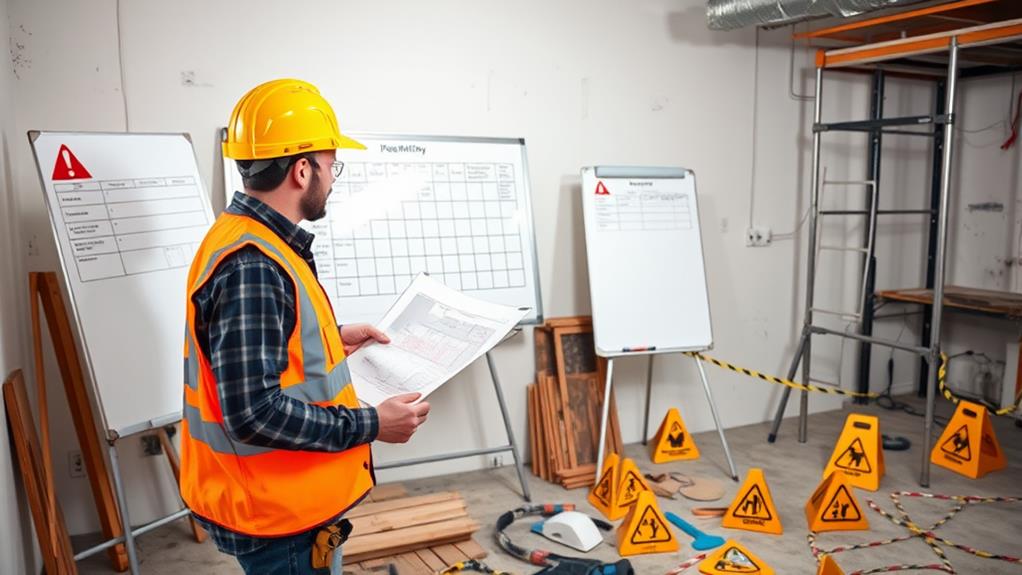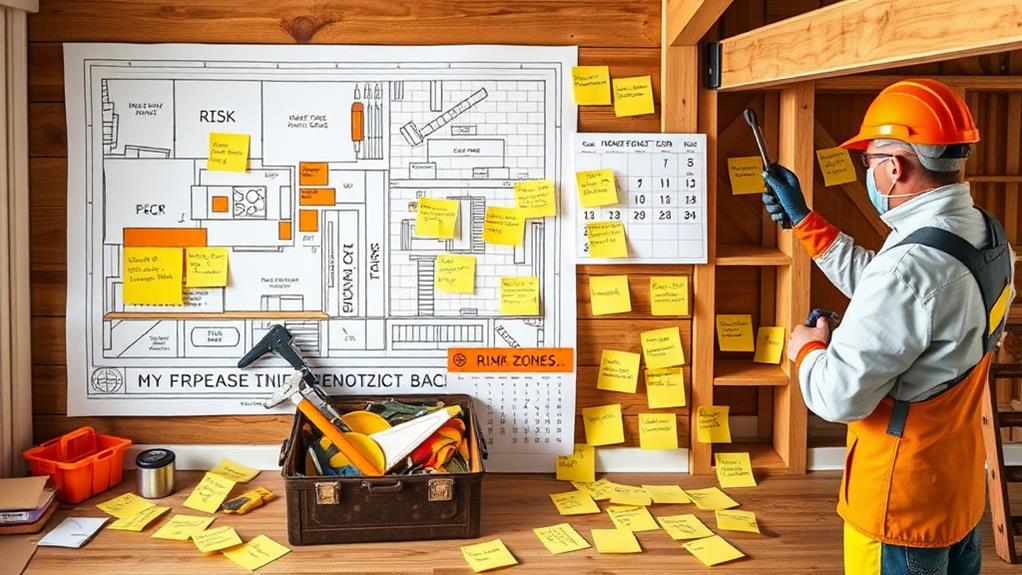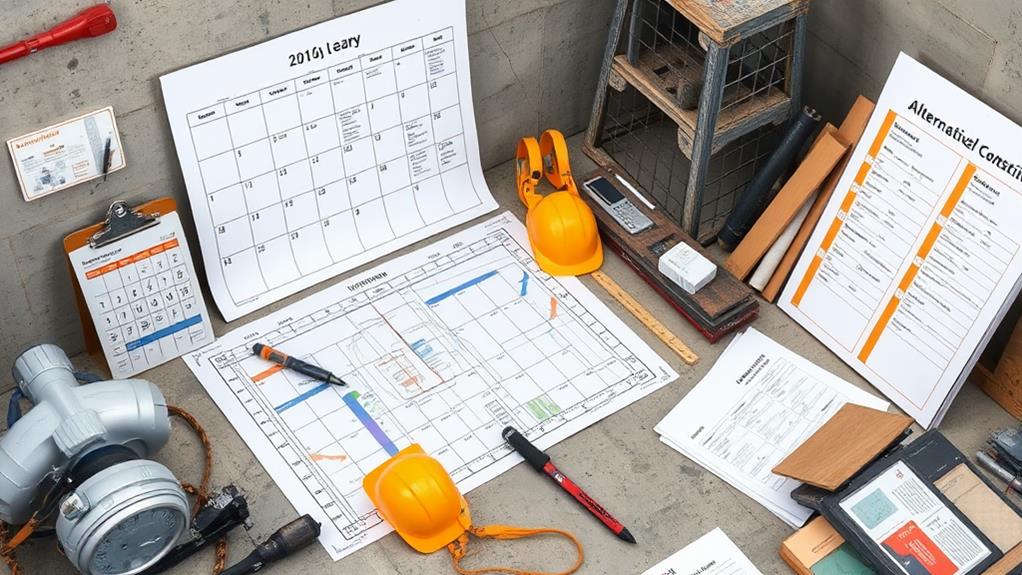Creating a risk management plan for your renovation project involves several key steps. Start by understanding the types of risks: financial, structural, and timeline-related. Identify potential hazards through thorough inspections and consultations with professionals. Assess the severity of each risk using a matrix that considers probability and impact. Prioritize risks based on their potential consequences and likelihood. Develop mitigation strategies for high-priority risks, allocating resources accordingly. Create contingency plans for unforeseen issues. Regularly monitor and track risks throughout the project, communicating with stakeholders as needed. A well-crafted risk management plan can significantly improve your renovation's chances of success. Exploring these steps in detail will equip you with valuable tools for your project.
Understanding Renovation Risks

Renovations involve three primary categories of risk: financial, structural, and timeline-related. Financial risks include unexpected costs, budget overruns, and changes in material prices. Structural risks encompass unforeseen issues with the existing building, such as hidden damage, outdated wiring, or asbestos. Timeline-related risks can stem from contractor delays, permit issues, or weather-related setbacks.
Understanding these risks is crucial for effective project management. Financial risks can be mitigated by thorough planning, obtaining multiple quotes, and including a contingency fund in the budget. Structural risks require comprehensive inspections and assessments before work begins, as well as working with experienced professionals who can identify potential issues. Timeline risks can be addressed by setting realistic deadlines, communicating clearly with all parties involved, and having backup plans for potential delays.
It's important to note that risks often interconnect. For example, discovering structural issues can lead to both financial and timeline-related challenges. By recognizing these connections and preparing for various scenarios, homeowners can better navigate the complexities of renovation projects and increase their chances of successful outcomes.
Identifying Potential Hazards
With a solid understanding of general renovation risks, the next step is to pinpoint specific hazards that may arise during your project. Begin by conducting a thorough inspection of the renovation site, paying close attention to structural elements, electrical systems, plumbing, and potential environmental hazards like asbestos or lead paint.
Create a comprehensive list of potential hazards, including:
- Structural instability
- Electrical shock or fire risks
- Water damage or leaks
- Exposure to hazardous materials
- Falls from heights
- Equipment-related injuries
- Dust and debris inhalation
- Noise pollution
- Chemical exposure
- Tripping hazards
Consult with professionals such as contractors, engineers, or safety experts to identify less obvious risks specific to your project. Consider the impact of weather conditions, especially for outdoor renovations. Assess the potential for accidents related to tools and machinery used during the renovation. Evaluate the risks associated with different stages of the project, from demolition to finishing work. By thoroughly identifying potential hazards, you can develop targeted strategies to mitigate risks and ensure a safer renovation process.
Assessing Risk Severity

Once potential hazards have been identified, the next crucial step is assessing the severity of each risk. This process involves evaluating the potential impact and likelihood of occurrence for each identified hazard. To effectively assess risk severity, consider factors such as the potential for injury, property damage, project delays, and financial losses.
Utilize a risk matrix to categorize risks based on their probability and impact. This visual tool helps prioritize risks by assigning them to low, medium, or high-risk categories. For each risk, estimate the likelihood of occurrence on a scale from rare to almost certain, and the potential impact from negligible to catastrophic.
Consider both short-term and long-term consequences when evaluating impact. Some risks may have immediate effects, while others could lead to prolonged issues. Consult with experts, such as structural engineers or safety professionals, to accurately assess technical risks. Additionally, review historical data from similar renovation projects to gauge the probability of specific risks occurring.
Prioritizing Risks
After assessing the severity of identified risks, the next step in creating an effective risk management plan is prioritizing these risks. Prioritization allows you to focus your resources and attention on the most critical issues that could impact your renovation project.
To prioritize risks, consider both their likelihood of occurrence and potential impact on the project's objectives, budget, and timeline.
One common method for prioritizing risks is the risk matrix, which plots each risk on a grid based on its probability and impact. Risks falling in the high-probability, high-impact quadrant should receive top priority. Another approach is the risk score method, where you assign numerical values to probability and impact, then multiply them to get a risk score. Risks with higher scores take precedence.
It's crucial to involve key stakeholders in the prioritization process to ensure diverse perspectives are considered. Regular review and adjustment of priorities are necessary as the project progresses and new information becomes available. By effectively prioritizing risks, you can allocate resources efficiently, develop targeted mitigation strategies, and increase the overall success of your renovation project.
Developing Mitigation Strategies

Effective mitigation strategies form the backbone of a robust risk management plan for renovation projects. These strategies aim to reduce the likelihood of risks occurring or minimize their impact if they do materialize. For each identified and prioritized risk, develop specific actions to address potential issues.
Common mitigation strategies include:
- Risk avoidance: Eliminating the risk by changing project plans or methods.
- Risk transfer: Shifting responsibility to another party, such as through insurance or subcontracting.
- Risk reduction: Implementing preventive measures to decrease the probability or impact of risks.
- Risk acceptance: Acknowledging and preparing for risks that cannot be avoided or mitigated.
When developing mitigation strategies, consider:
- Cost-effectiveness: Ensure the cost of mitigation doesn't outweigh the potential impact of the risk.
- Feasibility: Strategies should be realistic and achievable within project constraints.
- Timeline: Implement strategies at appropriate project stages for maximum effectiveness.
- Responsibility: Assign specific team members to oversee each mitigation action.
- Contingency plans: Develop backup strategies for high-impact risks.
Regularly review and update mitigation strategies as the project progresses to maintain their relevance and effectiveness.
Allocating Resources
Allocating resources is a critical step in implementing your risk management plan for renovation projects. This process involves assigning financial, human, and material resources to address identified risks and execute mitigation strategies effectively. Begin by prioritizing risks based on their potential impact and likelihood, then allocate resources accordingly.
Financial resources should be set aside as a contingency fund to cover unexpected costs or delays. This typically ranges from 10% to 20% of the project budget, depending on the project's complexity and risk level.
Human resources allocation involves assigning responsibilities to team members for monitoring and managing specific risks. Ensure that individuals have the necessary skills and availability to handle their assigned tasks.
Material resources may include equipment, tools, or supplies needed to implement risk mitigation strategies. Consider lead times for procurement and potential alternatives if primary resources become unavailable. Regularly review and adjust resource allocation throughout the project as new risks emerge or priorities shift. Effective resource allocation helps maintain project momentum, reduces the impact of potential risks, and increases the likelihood of successful project completion within budget and timeline constraints.
Creating Contingency Plans

Why are contingency plans crucial for renovation projects? Contingency plans serve as safety nets, providing predetermined strategies to address potential issues that may arise during the renovation process. These plans help mitigate risks, minimize delays, and control costs by offering alternative courses of action when unexpected challenges occur.
To create effective contingency plans, start by identifying potential risks specific to your renovation project. These may include weather-related delays, material shortages, or unforeseen structural issues. For each identified risk, develop a detailed response strategy outlining steps to be taken if the risk materializes.
Include alternative suppliers or subcontractors in your plans to ensure project continuity if primary resources become unavailable. Allocate a contingency budget, typically 10-20% of the total project cost, to cover unexpected expenses. Establish clear communication protocols for swift decision-making when implementing contingency measures.
Regularly review and update your contingency plans throughout the project lifecycle to ensure they remain relevant and effective. By having well-prepared contingency plans in place, you can navigate unforeseen challenges with confidence, keeping your renovation project on track and within budget.
Monitoring and Tracking Risks
Throughout the renovation process, diligent monitoring and tracking of risks are essential components of successful project management. Implementing a system to continuously assess and evaluate potential threats allows for timely intervention and mitigation strategies. This proactive approach helps prevent minor issues from escalating into major problems that could derail the project.
To effectively monitor risks, establish a regular review schedule and designate team members responsible for overseeing specific risk areas. Utilize tools such as risk registers, progress reports, and project management software to track identified risks and their status. Regularly update these documents to reflect changes in risk probability or impact.
Conduct periodic site inspections and team meetings to gather real-time information about potential issues. Encourage open communication among all stakeholders, including contractors, suppliers, and project managers, to ensure that new risks are promptly identified and addressed. Implement a system for reporting and escalating concerns, allowing for quick decision-making and resource allocation when necessary.
Communicating With Stakeholders

Effective communication with stakeholders forms the backbone of a successful risk management plan for renovation projects. It ensures that all parties involved are aware of potential risks, mitigation strategies, and their respective roles in managing these risks. Stakeholders may include project owners, contractors, subcontractors, suppliers, and regulatory bodies.
To establish clear communication channels, create a stakeholder communication plan that outlines the frequency, method, and content of communications. Regular updates should be provided through meetings, reports, or digital platforms. These updates should include risk assessments, newly identified risks, and the status of ongoing mitigation efforts.
Encourage open dialogue and feedback from all stakeholders to identify potential risks early and gather diverse perspectives on mitigation strategies. Establish a process for stakeholders to report new risks or concerns promptly. When communicating about risks, use clear, jargon-free language to ensure understanding across all levels of expertise.
In the event of risk materialization, have a crisis communication plan ready. This should outline steps for quick dissemination of information, decision-making processes, and designated spokespersons. By maintaining transparent and consistent communication, you can foster trust and collaboration among stakeholders, ultimately contributing to the project's success.
Updating the Risk Management Plan
A renovation project's risk management plan is not a static document; it requires regular updates to remain effective throughout the project lifecycle. As the renovation progresses, new risks may emerge, while previously identified risks may change in likelihood or potential impact.
To maintain an accurate and useful risk management plan, project managers should schedule regular review sessions, typically at key project milestones or at predetermined intervals.
During these updates, the team should reassess existing risks, evaluate the effectiveness of current mitigation strategies, and identify any new risks that have arisen. It's crucial to involve all relevant stakeholders in this process, as they may provide valuable insights from their respective areas of expertise. Any changes to the risk management plan should be clearly documented and communicated to the entire project team.
Additionally, the update process should include a review of the project's overall risk tolerance and appetite, as these may shift as the renovation progresses. By consistently updating the risk management plan, project managers can ensure that their team remains prepared to handle potential issues, ultimately contributing to the successful completion of the renovation project.
Frequently Asked Questions
How Often Should I Review and Update My Renovation Risk Management Plan?
Review and update your renovation risk management plan regularly, ideally monthly or at key project milestones. Additionally, reassess the plan whenever significant changes occur in scope, budget, or timeline, or when new risks are identified during the project's progression.
What Software Tools Can Help Streamline the Risk Management Process?
Several software tools can streamline risk management processes, including:
- Primavera Risk Analysis
- @Risk
- RiskyProject
- Active Risk Manager
- Resolver
These tools offer features like risk assessment, Monte Carlo simulations, and reporting capabilities to enhance decision-making.
How Do I Handle Unforeseen Risks That Emerge During the Renovation?
Like a sailor navigating stormy seas, flexibility is key. Address unforeseen risks promptly by:
- Assessing impact
- Developing mitigation strategies
- Adjusting project plans
- Communicating with stakeholders
- Documenting lessons learned for future reference
Should I Hire a Professional Risk Manager for My Renovation Project?
Hiring a professional risk manager for a renovation project depends on its scale and complexity. For smaller projects, it may be unnecessary. However, for large-scale or high-value renovations, a risk manager's expertise could prove invaluable in mitigating potential issues.
How Can I Effectively Communicate Risks to Contractors and Subcontractors?
To effectively communicate risks to contractors and subcontractors, hold regular meetings, provide detailed written documentation, use visual aids, encourage open dialogue, and ensure all parties understand their responsibilities and potential hazards associated with the project.
Conclusion
In the tapestry of renovation, a well-crafted risk management plan serves as the golden thread, weaving together safety, efficiency, and success. By navigating the labyrinth of potential hazards and implementing robust mitigation strategies, project managers can anchor their endeavors in a sea of uncertainty. Like a skilled conductor orchestrating a symphony, effective risk management harmonizes all aspects of the renovation process, ensuring a crescendo of triumph in the face of challenges.

